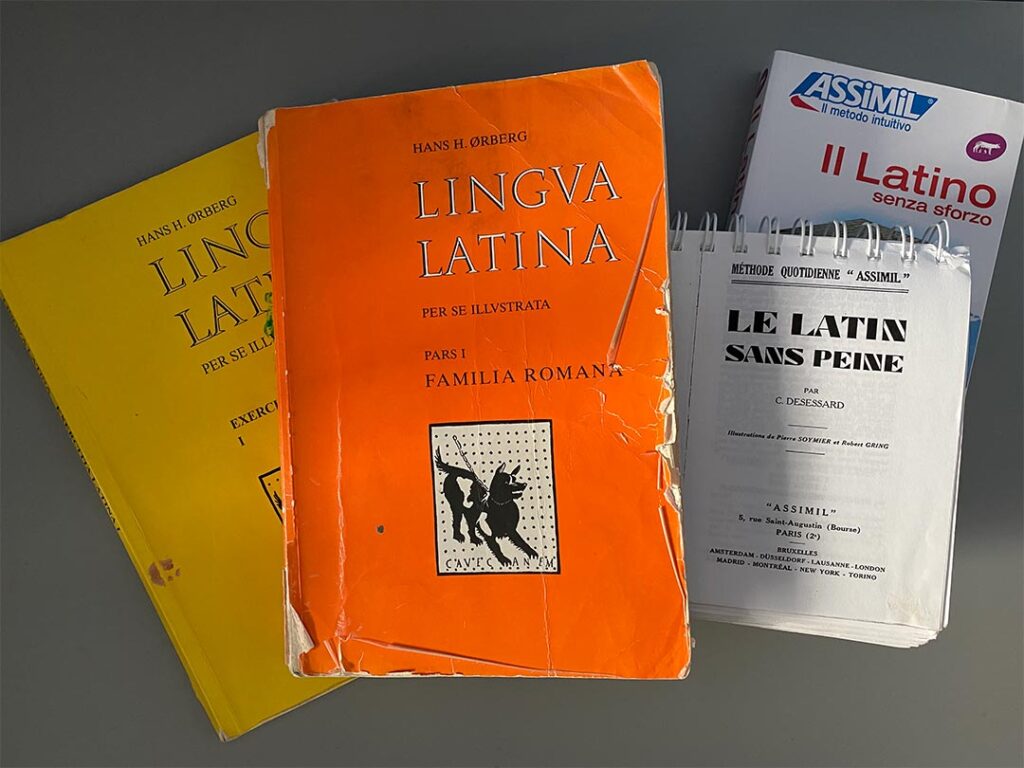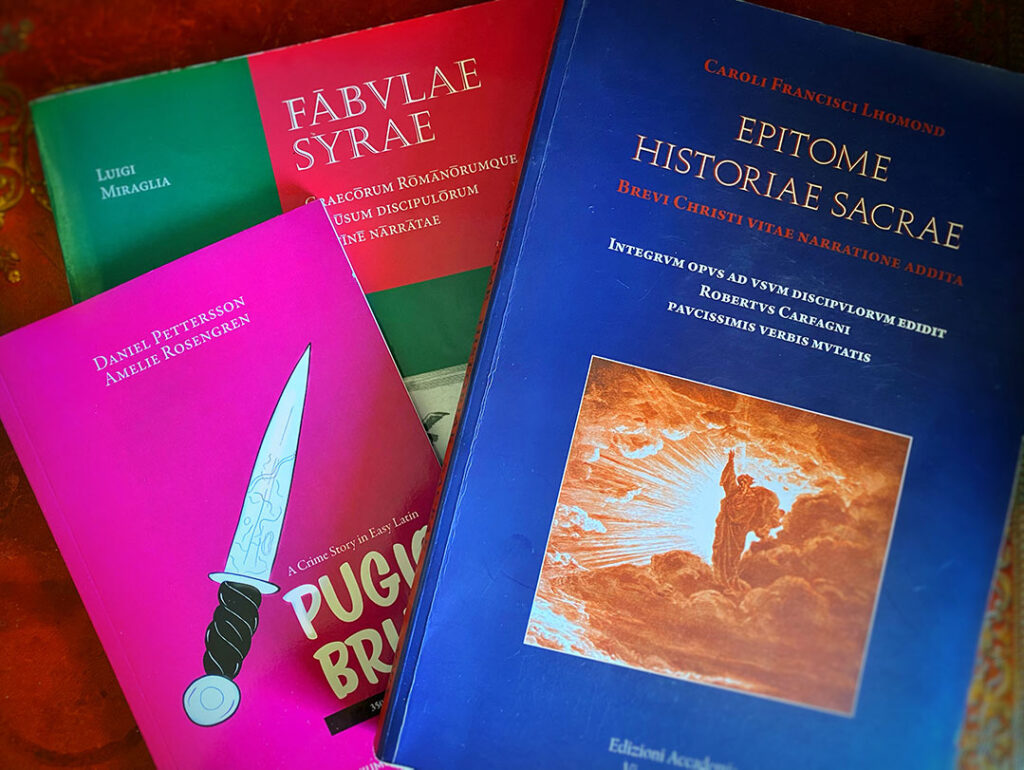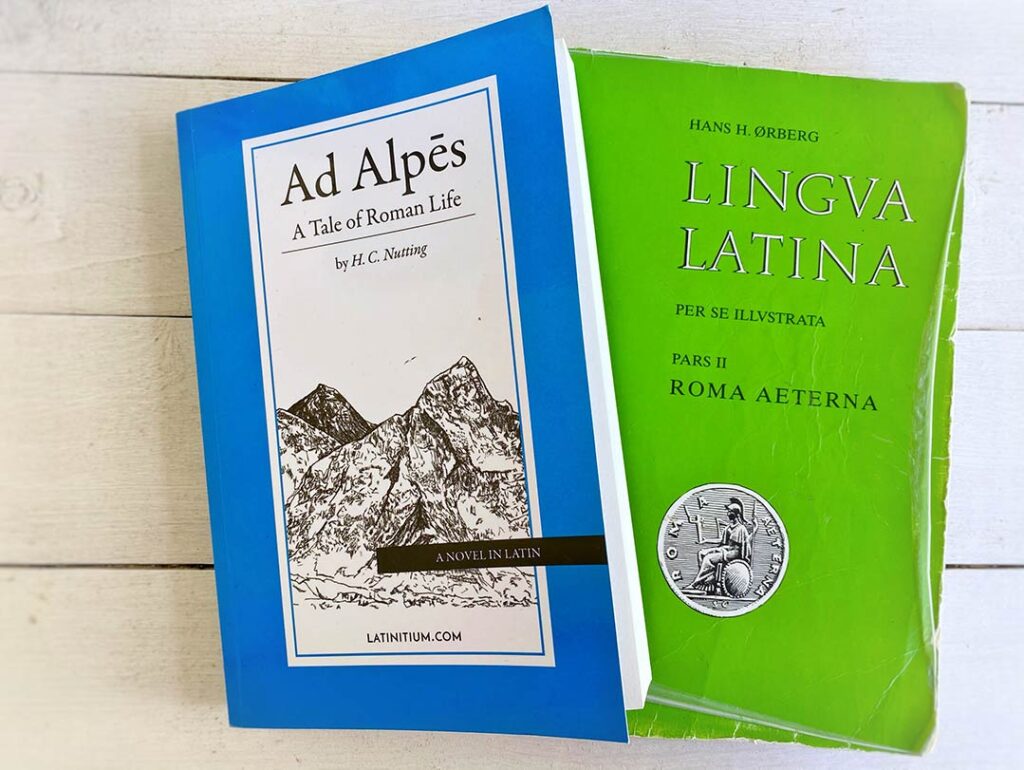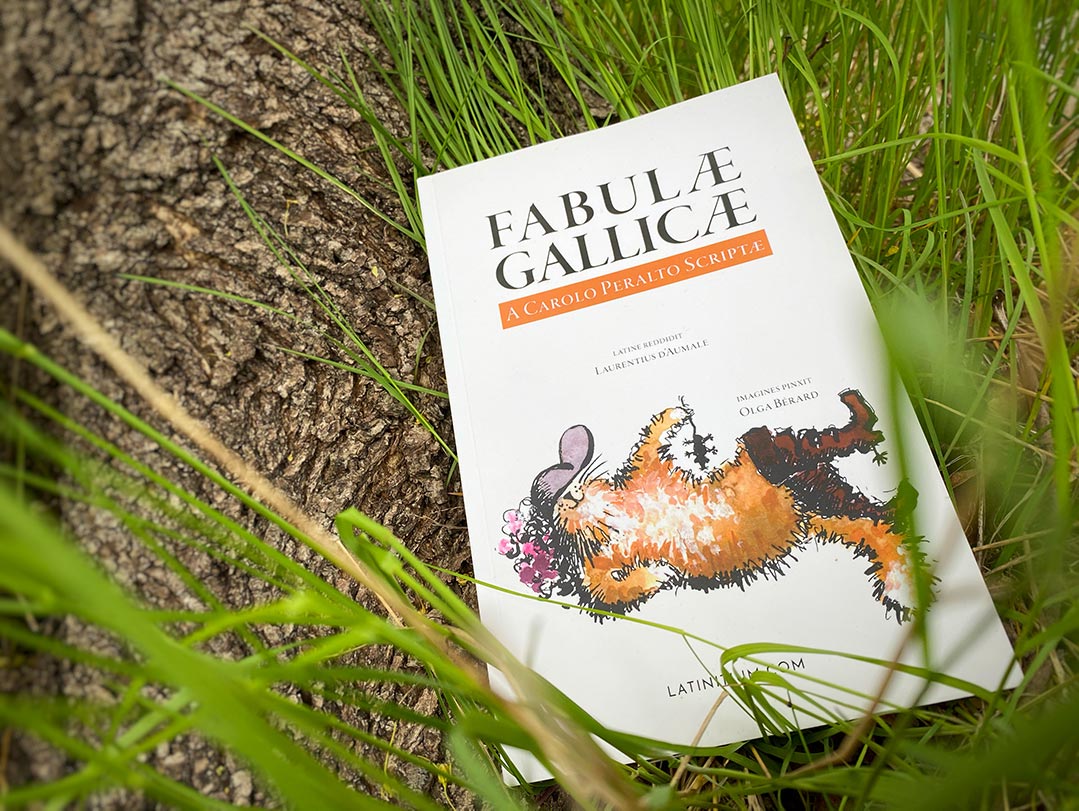Contents
- Best Textbooks For Learning Latin
- Best Latin Readers
- What is a Latin reader?
- Why do you need a reader? Isn’t a textbook enough?
- Fabulae Syrae
- Ritchie’s Fabulae Faciles
- Pugio Bruti — A Crime Story in Easy Latin
- Epitome Historiae Sacrae: Brevi Christi Vitae Narratione Addita
- Ad Alpes — A Tale Of Roman Life (2017 Edition)
- Roma Aeterna, (Lingua Latina Per Se Illustrata II)
- Fabulae Gallicae — Fairytales in Latin
- Best Latin Dictionaries
- Best Latin Prose Composition Book
- Final recommendations
Which are the best books for learning Latin? Which textbook or dictionary should I use? Are there any other books to consider? These are questions students ask me every year, so here are my recommendations for anyone learning Latin.
There are countless books out there, some popular, some unknown, or forgotten, and how do you know if any of them are any good? I’ve tried virtually all of them with students and for learning myself and found the best ones—with some room for bias—and I thought I’d share them with you. Note that there are numerous other great books to choose from; these are the ones I prefer, use, and recommend.
I’ve divided this guide into four parts:
- Latin textbooks
- Latin readers
- Latin dictionaries
- Latin prose compositions books
Let’s begin!
Best Textbooks For Learning Latin
These are the best textbooks on the market to start learning and mastering Latin. I recommend you get several books and work through them to build a large vocabulary.
Familia Romana (Lingua Latina Per Se Illustrata I)
Hans Ørberg
Familia Romana is by far the best book to get a strong foundation in Latin. I used it myself to learn Latin. I also use it in teaching and it’s the book I always recommend first when asked.
Familia Romana is entirely written in Latin and takes you from sentences like “Roma in Italia est” to longer intermediate texts. Marginal notes and images help explain new words without translating. The book centers around a Roman family but adds in some classical Latin texts towards the end. This is where to start.
Suggested reading: First day of learning Latin: what to do
Who should read Familia Romana?
Everyone who is learning Latin should read Familia Romana.
Exercitia Latina I: Exercises for Familia Romana, (Lingua Latina Per Se Illustrata I)
Hans Ørberg
Exercitia Latina I is the exercise book created for Familia Romana. It is not technically a textbook, but it is a great compliment to Familia Romana. And, while Familia Romana by itself is a fantastic book, the exercise book provides you with countless opportunities to drill the textbook’s morphology, syntax, and vocabulary. When I learned Latin many years ago, I went through the exercises in this book many times, both in writing and orally.
Colloquia Personarum, (Lingua Latina Per Se Illustrata I)
Hans Ørberg
Colloquia Personarum is a book of dialogues written so that each dialogue corresponds to the story and difficulty to a particular chapter in Familia Romana. It doesn’t stand on its own as a textbook, as it is written as a complement to Familia Romana. However, if you study this book in combination with Familia Romana and the Exercitia Latina I diligently, you will develop a perfect foundation, so that you will never have to think about endings and basic grammar again—you will know it instinctively. The three in combination make for the best textbook trio there is.

Assimil Le Latin Sans Peine
Clément Desessard
Assimil, Le Latin sans peine is a fun and great book, constructed with a very different philosophy than Familia Romana. It consists of 101 dialogues in Latin with a parallel translation in French (it is also available in Italian as Assimil Il Latino senza sforzo, and German as Latein ohne Mühe). Some of the dialogues are silly conversations in everyday situations, while others are passages taken from Latin literature, from Plautus to an early modern apothecary oath. Each dialogue also comes with notes on grammar and vocabulary.
The purpose of this book here is to have some fun while learning. The bite-sized format of each lesson makes it perfect for shorter study sessions.
To get the most out of Assimil, you need to listen to the recordings of all the dialogues repeatedly to start developing an intuitive understanding of Latin.
Assimil Le Latin Sans Peine is best used in conjunction with a complete foundational course in Latin like Familia Romana. This way, you get a strong foundation from FR while at the same time discover interesting passages from two millennia of Latin literature.
Note: There is another Latin textbook from Assimil by Isabelle Ducos-Filippi. I do not recommend this one; get the one by Clément Desessard.
Who should read Assimil Le Latin Sans Peine?
If you are not comfortable with a book entirely written in Latin and wish to have a translation, then Assimil is the book for you.
Although the translations and comments are in French, you could still get a lot out of the book by reading and listening to the dialogues. Without the French notes and translations, you should perhaps wait until you have a foundation in Latin.
It is also the book for you if you have already used the Assimil series when learning another language and found it worked for you. However, I strongly recommend you use Assimil Le Latin sans peine in conjunction with Familia Romana to get the most out of both of them.
Best Latin Readers
What is a Latin reader?
Latin readers is a genre of usually shorter books popular in the 19th and early 20th centuries. They were meant to bridge the gap between basic studies and reading classical literature. Some consist of selections from the classical canon, while others contain original or adapted Latin. Here we are talking about the latter of the two. Note that there are countless Latin readers, and here we only cite a handful of the best.
Why do you need a reader? Isn’t a textbook enough?
A good textbook, like Familia Romana, will teach you a good deal of the most frequent aspects of Latin in terms of vocabulary and grammar. However, to progress, you need to read more Latin beyond the textbook. Readers are a great way to encounter a wider range of vocabulary—and also subject matter.
Below you’ll find the best Latin readers, or books, for extensive reading. They differ in level and scope. I’ve noted below each book when it is suitable, or possible even, to read them. For the best result, you should strive to read them all, many times.
Fabulae Syrae
Fabulae Syrae contains myths and stories from the classical world retold in intermediate Latin. Each story corresponds to a chapter in the second half of Familia Romana and thus is a perfect companion to that book.
It’s also a great way to learn about the myths of the classical world that were ever-present in the minds of the Roman authors who had been steeped in them from childhood.
When can you read Fabulae Syrae?
I have my students study Familia Romana with a step-by-step method, and when they’ve finished the first half of the book, they start reading Fabulae Syrae as well. This is the way to go, as Fabulae Syrae will reinforce the material of the corresponding chapter in Familia Romana while also adding new vocabulary.
Ritchie’s Fabulae Faciles
Frank Ritchie
Ritchie’s Fabulae Faciles is a classic Latin reader from the 19th century. It is an entertaining book to read, with stories about Hercules, Odysseus, Perseus, and Jason and the Argonauts.
Fabulae Faciles was written to provide learners with a stepping stone to Caesar’s De Bello Gallico, which has traditionally been the first Roman text students read. For this reason, it is written in a straightforward style, with frequent use of the most common turns of phrases from Caesar, e.g., his rebus constitutis (“Having decided upon these things”). If you read and re-read this, you will build your vocabulary and knowledge about the myths of the classical world.
You can find an edition which has Latin text with facing vocabulary and commentary here.
When can you read Ritchie’s Fabulae Faciles?
If you have worked through Familia Romana methodically and diligently, you will be able to read Fabulae Faciles comfortably. The best thing to do is to read Fabulae Syrae first as there will be a lot of overlapping vocabulary and subject matter. Then you continue to Fabulae Faciles; There might be some words or points of grammar that are difficult in Fabulae Faciles, but then you can check the glossary and the comments in this edition.

Pugio Bruti — A Crime Story in Easy Latin
Daniel Pettersson, Amelie Rosengren
I am very biased with regards to this book, being one of its authors. It is the type of book that I wished I had myself when learning Latin many years ago: an exciting short novel in a very classical style.
Pugio Bruti is a crime story set in Augustan Rome where a young woman, Terentia, hunt’s for the truth about her father’s dagger. The book is written in easy but classicizing Latin with a vocabulary of fewer than 350 words. It comes with a full Latin-English vocabulary. To complement the book, you can listen to the audiobook version and work through the online course video course. There are also quite a few free extra resources online
When can you start reading Pugio Bruti?
I suggest you finish at least the first half of Familia Romana before you begin reading Pugio Bruti. If you feel uncertain of your level, there is help in the form of the full Latin-English vocabulary in the book and a glossary (where you can find every form of the words) free online. The book also repeats words in different ways so that a word you might not understand, to begin with, will become part of your vocabulary once you’ve finished the book.
Epitome Historiae Sacrae: Brevi Christi Vitae Narratione Addita
Charles Lhomond, Roberto Carfagni
Epitome Historiae Sacrae is a 17th-century Latin reader written all in Latin with stories from the Bible in an (upper) intermediate Latin. The great variety of the stories will substantially enrich your vocabulary while still being enjoyable. My students enjoy this book both for the vocabulary and because the familiarity of the stories makes them much more comprehensible.
You can find an edition that has marginal notes explaining new or difficult words all in Latin here. This edition also has various exercises, including crosswords and matching.
When can you read Epitome Historiae Sacrae?
Due to the large vocabulary, Epitome Historiae Sacrae is more difficult than the previous ones on this list. You should finish (i.e., not just reading it once) Lingua Latina Part I: Familia Romana and the exercise book, and you’ll be able to read Epitome Historiae Sacrae without too much trouble.
Ad Alpes — A Tale Of Roman Life (2017 Edition)
H. C. Nutting
Years ago, I stumbled upon this Latin reader, and reading it made me so happy. Ad Alpes is a unique book and, I would argue, one of the best Latin readers out there. It is both a novel with an overarching narrative and a Latin reader with over 200-pages of stories in Latin from the ancient world. Woven into the book’s narrative, you will find countless passages from various Latin authors, and as such, truly prepares you for reading the classical authors.
Reading (or listening) to this book over and over again will give you a vast vocabulary and a good grasp of more advanced grammar. It comes with a full Latin-English vocabulary and is available as a paperback, e‑book, and audiobook.
Who can read Ad Alpes?
It is best to have a good grounding in Latin grammar and vocabulary before reading Ad Alpes. So, read and study Famila Romana, Fabulae Syrae, Fabulae Faciles, Epitome Historiae Sacrae before you start Ad Alpes.

Roma Aeterna, (Lingua Latina Per Se Illustrata II)
Hans Ørberg
Roma Aeterna is the second volume of the Lingua Latina per se illustrata series and takes the learner through Roman history and myth via passages from Roman historians and poets such as Livy, Sallust, and Ovid.
Before diving into Roman literature, Roma Aeterna first retells the first four books of Virgil’s Aeneid in straight-forward Latin prose. Thereafter it covers central events in Roman history through a wide variety of readings accompanied by short explanations of grammar and exercises.
Who can read Roma Aeterna?
Although Roma Aeterna is meant to be read after Familia Romana (and the ancillary books of the Lingua Latina Per Se Illustrata series, our students often find that there is too large a gap.
I would therefore suggest reading and mastering the Latin readers Fabulae Faciles and Epitome Historiae Sacrae before reading Roma Aeterna—unless Roman history is a passion of yours.
Fabulae Gallicae — Fairytales in Latin
Charles Perrault (author), Laurent d’Aumale (translator)
Fabulae Gallicae is a Latin translation of Charles Perrault’s fairytales from 1697. The book contains eight classical fairytales; Cinderella, Diamonds and Toads, Bluebeard, Little Red Riding Hood, Little Thumbling, Puss in Boots, Donkeyskin and Sleeping Beauty. However, the fairytales are not the Disney versions of the stories, which means that even though you know the stories, plots and endings might come as a surprise.

Most readers and books written for Latin learning favor stories from Rome, antiquity, myths, or the Bible. Fabulae Gallicae is, therefore, a welcome breath of fresh air, as it provides something completely different to read.
There are two versions of the book: a paperback and an e‑book. Both contain a glossary in three languages: French, English, and Spanish.
Who can read Fabulae Gallicae?
You need to be at a rather advanced level to read Fabulae Gallicae easily, as it is written in a highly classicizing style. I read one of the stories, Magae–or, Diamonds and Toads–in our Book Club if you are curious about the level. You can find the video here.
Best Latin Dictionaries
Having a good dictionary is crucial for learning Latin, but it’s hard to know which ones are good. For a comprehensive guide and comparison of Latin-English dictionaries, read: What are the best Latin-English dictionaries for Learning Latin?
Below I’ve noted the ones I deem to be of most interest, both large scholarly ones and smaller ones for beginners and intermediate students.
The Bantam New College Latin & English Dictionary
John Traupman
The Bantam New College Latin & English Dictionary is a popular medium-sized 700-page dictionary with 70.000 words and phrases. It also includes sections that might be of use when you’re learning Latin, such as pronunciation, grammar, history, mythology. It is not only a Latin-English dictionary but has an English-Latin section as well. Bantam stands out, containing slang, vulgar expressions, and neo-Latin vocabulary.
Who should use Bantam’s dictionary?
The Bantam New College Latin & English Dictionary is a great dictionary if you want a good all-in-one resource and be able to look up a word and get a general idea of its meaning. But for reading classical authors, I recommend a larger dictionary.
Cassell’s (Standard) Latin Dictionary
D. P. Simpson
Cassell’s Latin Dictionary is very popular and rather comprehensive. Its 880 pages focus on Latin from 200 B.C. to 100 A.D. and contain both a Latin-English and an English-Latin section. What sets this dictionary apart from Bantam’s are the many examples of usage taken from Latin literature and a section with idiomatic expressions, which I highly appreciate.
Who should use Cassell’s Latin Dictionary?
Cassell’s Latin Dictionary is excellent if you study Latin and read Classical texts beyond a few sentences here and there. It gives most of what you need without being too overwhelming.
Lewis & Short (A Latin Dictionary, or Harpers’ Latin Dictionary)
Charlton Thomas Lewis, Charles Short
Lewis & Short is, without a doubt, the most commonly used Latin-English dictionary by both learners and scholars. It is also one of the most comprehensive dictionaries with Latin from the 2nd century B.C. to the 8th century A.D. comprising 2000 pages with countless examples from literature, notes on usage, and etymology. It is also freely available online.
It has been criticized throughout the years for slight inaccuracies, both regarding definitions and, more particularly, to vowel quantities. It is still an excellent and impressive dictionary.
Who should use Lewis & Short?
Lewis & Short is mainly a Latin dictionary for advanced students and scholars. It is also the standard dictionary amongst scholars reading later Latin.
Oxford Latin Dictionary
P.W. Glare (editor)
Oxford Latin Dictionary is an enormous dictionary of 2400 pages, covering Latin up to 200 A.D., excluding most Christan writers.
Like Lewis & Short, it is a Latin-English dictionary only and provides the user with examples from literature and notes on usage and etymology. However, it differs from Lewis & Short in that it’s not based on previous dictionaries but is a completely new work taking modern research into consideration.
I find that one of Oxford Latin Dictionary’s greatest strengths lies in the clear disposition of its articles which makes finding the relevant sense comparatively easy for the reader.
Who should use Oxford Latin Dictionary?
If you are an advanced learner and want to dive deep into the different nuances and usages of words, Oxford Latin Dictionary is a great resource. I would suggest you use both Lewis & Short and OLD.
Best Latin Prose Composition Book
If you want to get really good at Latin and master it well, one of the best things to do is follow a good Latin prose composition coursebook and start practicing your writing skills. Writing Latin helps you build confidence in your ability to actually wield the language and understand it deeply.
Suggested reading: Latin prose composition: Books and Method
Bear in mind that “Latin prose composition” here means translating select sentences and passages from English into Latin to practice a particular aspect of the language. It is thus not creative writing.
I have learned an immense amount from translating into Latin as it helped me find out what you I didn’t know or hadn’t noticed in reading.
Note! Translation exercises are useful, but they will be of little use without ample reading of level-appropriate Latin.
Below are my two favorite Latin prose composition books:

North & Hillard’s Latin Prose Composition
North & Hillard’s Latin Prose Composition is a classic aimed at students beginning to write Latin. The method is focused on translation from English into Latin. Note, the book still requires a complete understanding of Latin morphology, as the book focuses on teaching syntax and vocabulary. The book starts with some preparatory exercises, which are very simple, but the actual exercises are more difficult.
The book follows a simple structure: each chapter first briefly explains a point of grammar such as the genitive of quality or final clauses. Next, there are a few examples of the grammatical point of the chapter with English translations. Finally, there are the exercises themselves, which consist of short, disjointed sentences in which the grammar points of the chapter are to be used.
After a few chapters, there are summary exercises. These are coherent paragraphs relating a short story or an episode from history. In these summary exercises, the grammar and vocabulary of the previous chapters are practiced together.
North & Hillard has a full glossary of all the words and expressions you will need for doing the exercises.
I have most of my students go through this book diligently. Although the style and contents of the book might seem rather arid to students, the result from using it is always the same: My students master the most important aspects of grammar and phraseology intimately. In addition, this hyper-focus on particular aspects of the language makes noticing the same things while reading much more likely. “Oh, this is the same structure that I practiced using in North & Hillard!”.
When can you use North & Hillard?
Start working on North & Hillard after gaining a firm grounding in Latin, preferably after Familia Romana, providing you study it methodically.
Bradley’s Arnold Latin Prose Composition
Bradley’s Arnold Latin Prose composition is the standard textbook for more advanced composition practice. It aims at teaching you to write a classical Latin following the example of Caesar and Cicero. To do this, the chapters are divided into grammatical topics. Each chapter focuses on one aspect, e.g., the accusative and infinitive, conditional clauses, or indirect speech.
The chapters first introduce the grammar point with explanations in English with example sentences in Latin elucidating the points. Next, follow isolated sentences in English to translate into Latin. These sentences are written to be translated using the current chapter’s grammatical topic while also practicing previous points.
When I was learning Latin, I went through Bradley’s Arnold countless times, both in writing and orally. Afterward, I gained newfound confidence in my knowledge of Latin idiom and grammar. It’s a detailed course and will deepen your knowledge immensely while also making reading Latin much easier and more rewarding.
However, if your goal is to write Latin well, this course is only the beginning: you will have to read and write for years to develop your style and vocabulary.
When can you study Bradley’s Arnold?
You can start studying Bradley’s Arnold after you know Latin morphology well and have a good-sized vocabulary. First, master the contents of Familia Romana by Hans Ørberg and several readers, and then go through North & Hillard’s Latin prose composition, which functions well as an introduction to writing Latin.
Final recommendations
Now you have an idea of which books to get and study to learn Latin well. Remember that there are many other books not on this list that may be equally good. Nevertheless, these are books that I have used successfully myself to attain fluency in speaking and reading Latin.
Do not rush through the books; learning Latin can be and should be a pleasureful experience and not the “necessary evil” you have to pass through to learn it. Keep reading and studying consistently, and over time you will be able to read, and if you want to, speak Latin well. It only takes time and reading.
Good luck!
*This article contains affiliate links, which means that we make a small commission from any sales—without affecting the price for you.
















